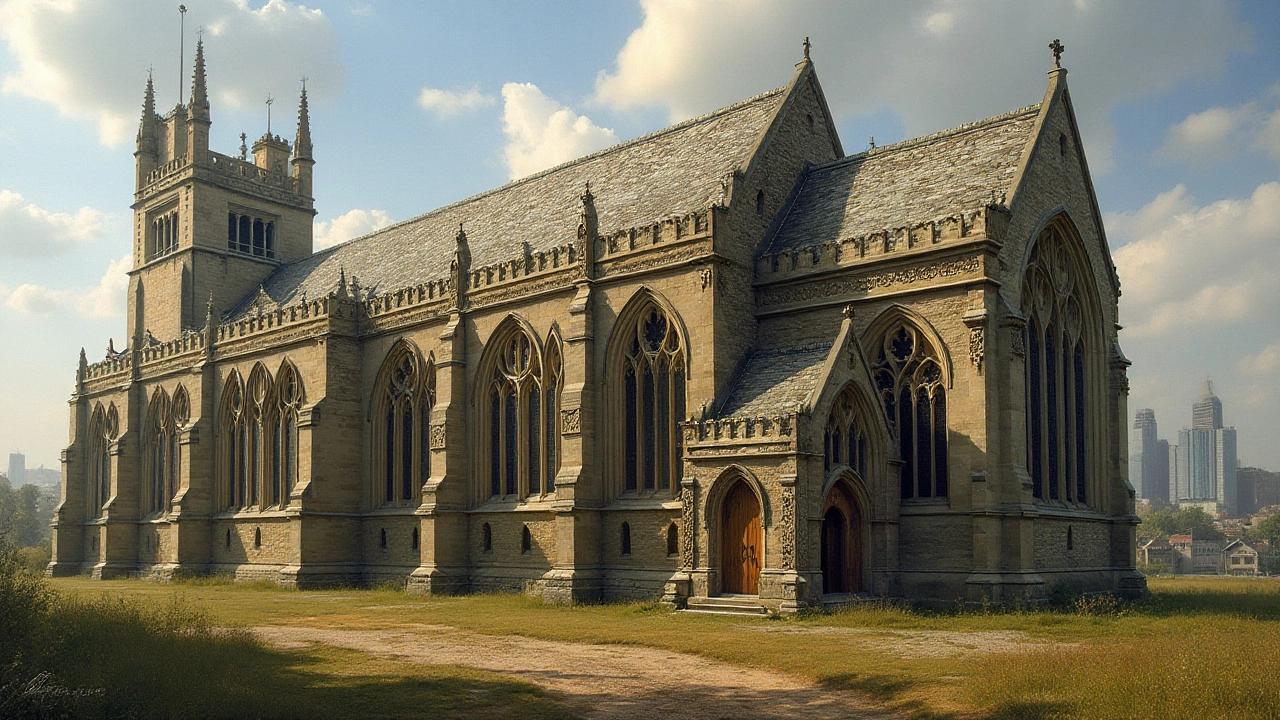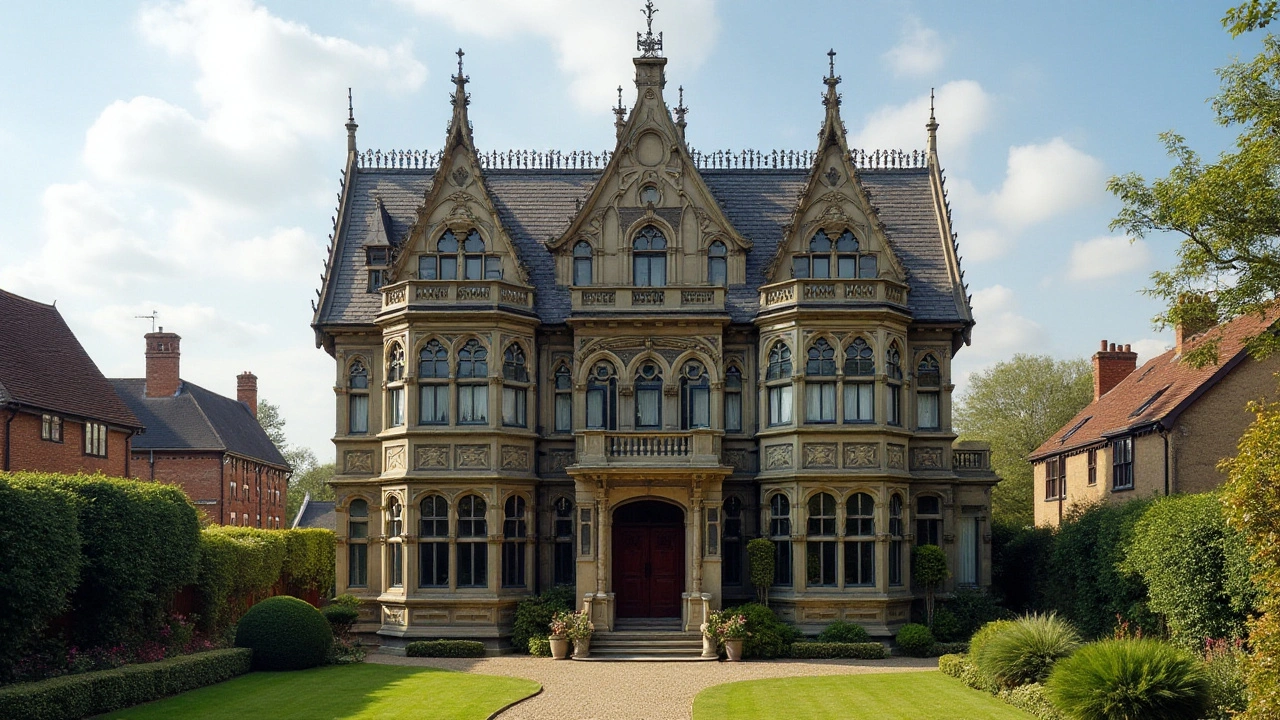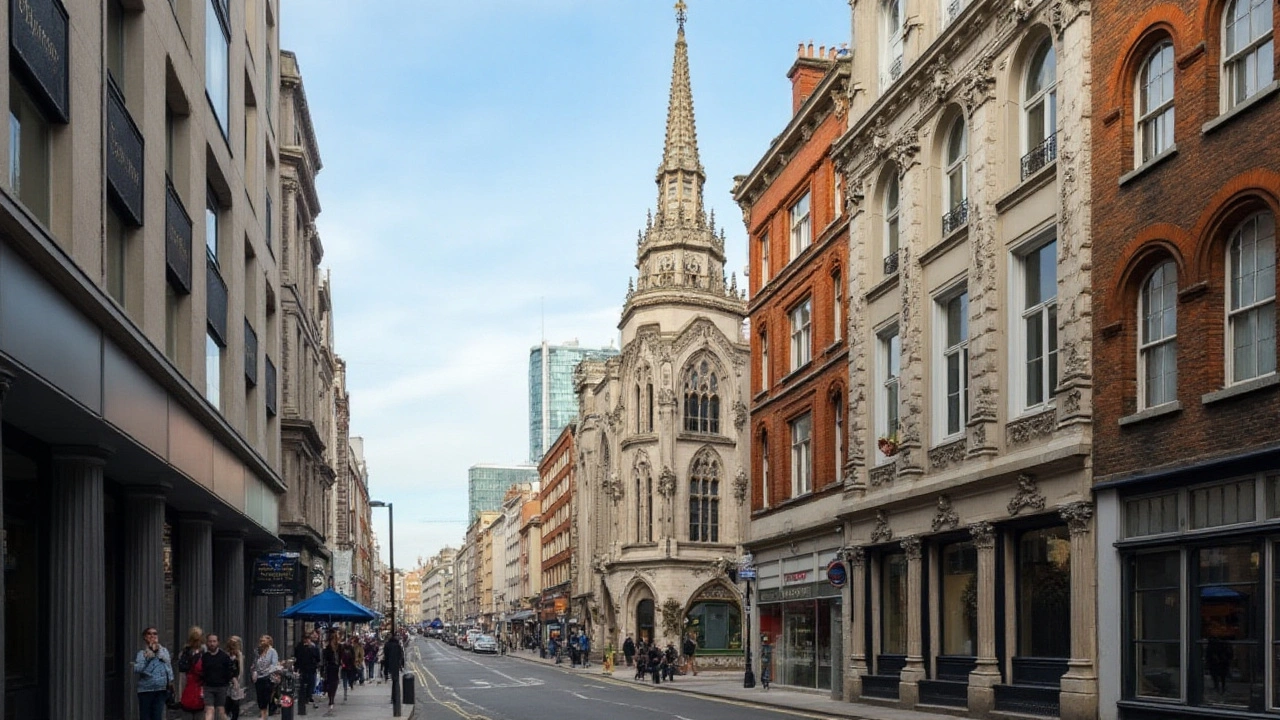Why Gothic Revival Architecture Matters in Modern Times
 Sep, 2 2024
Sep, 2 2024
Gothic Revival architecture, deeply rooted in the aesthetics of medieval Gothic style, came to prominence in the 19th century. Yet, its relevance persists even today, weaving a rich tapestry of historical charm and modern functionality.
This article aims to shed light on why Gothic Revival remains a beloved architectural style. By diving into its origins, key features, and modern applications, we'll uncover what makes this enduring design both historically significant and practically appealing. Additionally, we'll explore famous examples and offer practical tips on how to bring Gothic Revival elements into your own living space.
- Origins and Evolution
- Key Features of Gothic Revival
- Modern Applications
- Famous Examples
- Cultural Significance
- Tips for Incorporating Gothic Revival in Your Home
Origins and Evolution
The Gothic Revival style, also known as Neo-Gothic, began in the late 18th century in England, amidst a growing fascination with the Middle Ages. Initially, this architectural movement was about more than just building design; it reflected a broader cultural interest in the medieval period, encompassing literature, art, and even politics. The Gothic Revival reacted against the classical styles that had dominated architectural design for several centuries.
One of the early champions of the Gothic Revival was the writer Horace Walpole, who transformed his home, Strawberry Hill, into a Gothic fantasia complete with turrets, battlements, and pointed arches. Walpole's creative exploration of medieval aesthetics set a precedent for later architects. This period also witnessed the publication of influential books like John Ruskin's 'The Seven Lamps of Architecture,' which argued for the moral superiority of Gothic architecture. According to Ruskin, "Gothic architecture represents freedom and naturalness, serving as a counterpoint to the rigidity of classical forms."
As the style evolved, it became more codified and formalized. Architects like Augustus Pugin significantly influenced the movement, promoting it as the ideal architectural style for Christian churches. He believed that Gothic architecture symbolized moral and spiritual purity. Pugin's detailed studies and architectural works inspired the broader adoption of Gothic Revival elements in public buildings, homes, and educational institutions.
During the 19th century, the movement spread beyond England to America and Continental Europe. In the United States, Gothic Revival found fertile ground in both ecclesiastical and residential architecture. It was especially popularized by architects like Richard Upjohn, who designed the iconic Trinity Church in New York City, demonstrating the style's adaptability and enduring appeal. Meanwhile, in Canada, buildings like the Parliament Hill in Ottawa showcased the majestic and ornamental qualities of Gothic Revival, attesting to its international reach.
A notable aspect of Gothic Revival architecture is its adaptability. Though rooted in medieval ideals, the style has frequently incorporated contemporary materials and techniques. For example, the Houses of Parliament in London, designed by Charles Barry and Augustus Pugin, utilized cast iron and gas lighting, reflecting both medieval inspiration and modern innovation. Gothic Revival thus served as a bridge, connecting the past's artistic traditions with the present's technological advancements.
As the 20th century approached, the popularity of Gothic Revival began to wane, supplanted by other architectural trends like Art Deco and Modernism. However, its impact lingered, and the style experienced periodic revivals, particularly with movements like the Collegiate Gothic in American university architecture during the early 20th century. Today, the influence of Gothic Revival is still visible in many renovated historical buildings and even some new constructions that seek to capture a timeless, historic charm.
Key Features of Gothic Revival
Gothic Revival architecture, also known as Neo-Gothic, captures the essence of medieval Gothic design with a twist of modern interpretation. One of the most distinguishing features is the use of pointed arches. These arches are not merely for show; they serve a structural purpose by distributing weight more evenly, allowing buildings to reach soaring heights. This structural ingenuity paved the way for the magnificent cathedrals and churches that are so iconic of this style.
Another hallmark of Gothic Revival is the ribbed vault. This enabled architects to create complex, intricate ceilings that not only looked stunning but were also incredibly stable. The ribbed vaults paired with flying buttresses revolutionized the way buildings were constructed, allowing for larger windows and more airy spaces.
The windows themselves in Gothic Revival buildings are a sight to behold. Typically, you will find large, pointed stained glass windows. These windows are filled with vibrant colors and intricate designs that often tell a story or depict religious scenes. Stained glass windows were more than just decorative elements; they served to illuminate interiors with colorful light, creating an ethereal atmosphere.
A prominent feature that makes Gothic Revival unique is its ornamental flair. Gargoyles, spires, and pinnacles adorn the exteriors of these structures. These aren't just decorative elements but also functional. For instance, gargoyles often act as water spouts, directing rainwater away from the building. The intricate stone carvings are like works of art, showcasing an astonishing level of craftsmanship and attention to detail.
Gothic Revival is not just about the grandiose exterior elements; the interiors are equally captivating. You'll often find detailed woodwork, elaborate altars, and intricately designed pews in these buildings. The interior design aims to complement the architectural integrity of the exterior while creating a sense of awe and reverence.
One might be surprised to learn that Gothic Revival also places a strong emphasis on natural light. The large windows and strategic layout allow sunlight to flood the interiors, making the spaces feel more open and inviting. This feature is particularly effective in churches, where the interplay of light and color elevates the spiritual experience.
It's worth noting that Gothic Revival architecture is not confined to religious buildings. It extends to residential constructions as well. Many homes built during the Gothic Revival period feature steeply pitched roofs, decorative gables, and intricate wooden trims, creating a fairy-tale-like aesthetic.
The Gothic Revival style continues to influence modern architecture. While today's architects might not incorporate all elements, the essence of the style—its emphasis on verticality, light, and intricate details—lives on. This blend of historical and modern elements makes Gothic Revival a timeless architectural style that's still highly relevant today.
According to architectural historian John Ruskin, "Architecture is the art which so disposes and adorns the edifices raised by man... that the sight of them contributes to his mental health, power, and pleasure." His perspective encapsulates the enduring allure of Gothic Revival architecture.

Modern Applications
When thinking about Gothic Revival, it's easy to imagine grand cathedrals and ornate historic buildings, but this architectural style has found a place in today's modern world. One of the fascinating aspects is how it adapts to modern needs without losing its distinctive charm.
Contemporary architects have creatively integrated Gothic Revival elements into residential and commercial spaces. Homes now incorporate the high, arched windows and intricate woodwork that define the style, while using modern materials like steel and concrete. These elements provide a unique blend of old and new, offering both aesthetic beauty and structural stability.
Commercial buildings are not left behind. Many universities and institutional buildings continue the tradition of Gothic grandeur but with a sleek, modern twist. For example, the University of Chicago's campus masterfully combines neo-Gothic structures with modern buildings, creating an environment that is both inspiring and functional.
Moreover, public spaces like parks and libraries take cues from Gothic Revival. Case in point: New York’s Cathedral Church of St. John the Divine, an ongoing project that merges Gothic elements with modern design considerations, making it both a spiritual haven and an architectural marvel.
Interior designers are also borrowing from the Gothic Revival playbook. High ceilings, pointed arches, and intricate moldings add an imposing yet cozy elegance to modern homes. Rooms designed with this style often feature dramatic lighting and rich, dark furniture that harks back to the medieval era, yet feel entirely contemporary.
"The Gothic Revival style allows us to engage with history while meeting today’s architectural needs," says renowned architect Sarah Woodford. Her work seamlessly blends the ornate with the practical, creating spaces that are both functional and beautiful.
Another modern application is seen in the use of eco-friendly materials that mimic the essence of traditional Gothic structures. Architects now experiment with renewable resources, creating sustainable buildings that pay homage to history while looking forward to the future.
In high-tech environments, like Silicon Valley, you'll find Gothic-inspired detailing sneaking into tech campuses. This juxtaposition of medieval style with cutting-edge technology offers a unique visual and functional experience. Imagine working under high, vaulted ceilings in a space that also houses state-of-the-art technology – it's an inspiring intersection of two worlds.
In essence, Gothic Revival architecture's adaptability makes it relevant today. Its ornate features bring a sense of history and grandeur to modern spaces, while its structural strengths meet contemporary needs. Whether in homes, public buildings, or tech campuses, the style continues to evolve, proving that it’s much more than a relic of the past.
Famous Examples
Gothic Revival architecture has given the world some truly awe-inspiring structures that seamlessly blend beauty and strength. The Houses of Parliament in London stand as one of the most iconic examples of this architectural style. Rebuilt in the mid-19th century after a devastating fire, this sprawling complex is a symphony of spires, intricate stonework, and pointed arches. Designed by Charles Barry and Augustus Pugin, it's a testament to the majesty and stamina of Gothic Revival.
In the United States, New York City boasts several notable Gothic Revival landmarks. One striking example is the Trinity Church located at the intersection of Wall Street and Broadway. Completed in 1846, it was the tallest building in NYC until 1890. The church features a gothic spire that can be seen from blocks away and is adorned with beautiful stained glass windows, elaborate carvings, and other hallmarks of the style. This building not only serves as a place of worship but also a historical landmark visited by thousands each year.
Far from the urban hustle, Strawberry Hill House in Twickenham, England, offers a different perspective on Gothic Revival. This villa was built by Horace Walpole, an author and politician, in the 18th century. Its facade is a delightful mix of turrets, battlements, and pointed windows, giving it the look of a fairytale castle. The interior is equally enchanting, featuring elaborate ceilings, fantastical decorations, and hidden passages. This house showcases the playful and whimsical side of Gothic Revival.
Across the Atlantic, another splendid example is the National Cathedral in Washington, D.C. This magnificent edifice took 83 years to complete and serves as a key religious and cultural symbol of the United States. Its towers, stained glass, and sculptures are all textbook examples of Gothic Revival intricacy. To this day, it hosts a variety of events ranging from state funerals to holiday celebrations, demonstrating the style's lasting utility and grandeur.
For those intrigued by academic settings, Oxford University offers Christ Church Cathedral and the iconic Radcliffe Camera. The cathedral is amongst the smallest in England, but its design is big on charm with finely detailed carvings, ribbed vaults, and beautiful cloisters. The Radcliffe Camera, while technically more neoclassical, has a Gothic spirit that harmonizes perfectly with the university's older buildings, adding an extra layer of historical resonance.
"Gothic Revival continues to captivate because it offers a tangible link to the past while allowing for creative interpretation," notes historical architect Mark Wilson Jones.
"Its adaptability makes it suitable for a range of projects, from sacred spaces to educational institutions, to personal residences."

Cultural Significance
Gothic Revival architecture carries deep cultural roots, bridging the gap between the medieval past and the modern present. When examining its cultural significance, its connection to the Romantic Movement in the 19th century pops up prominently. This movement sought to revive the perceived mysticism, spirituality, and community-centered attributes of medieval architecture, reacting against the industrial revolution's mechanization and uniformity. Gothic Revival brought a sense of artistry and individuality back into the urban landscape, providing a counterpoint to the rapidly changing world.
The style also serves as a visual narrative of historical transitions. Churches and cathedrals are the most notable examples. They showcase elements like pointed arches, ribbed vaults, and flying buttresses. These weren't just architectural choices but symbolic gestures towards reaching the heavens. It's no wonder that even today, these spaces can evoke a sense of awe and reverence.
A fascinating aspect of Gothic Revival is its role in nation-building. In the UK, for example, the *Houses of Parliament* are perhaps the most famous Gothic Revival structure, designed by Charles Barry and Augustus Pugin. They echo a period when the country was solidifying its global influence, and thus, the architecture of power had to reflect longevity, tradition, and stability. The United States also embraced this style, visible in university campuses like *Yale* and *Princeton*. These structures aimed to evoke the scholarly rigor and academic prestige of medieval universities like *Oxford* and *Cambridge*.
The renowned art historian Nikolaus Pevsner once said, "The term 'Gothic Revival' implies a return to an old mode; it denotes a conviction that the past holds lessons worth learning." This sentiment captures the cultural underpinnings of the Gothic Revival movement, emphasizing its educational and moral aspirations.
Gothic Revival architecture also paved the way for public appreciation of historical styles. This period saw the genesis of architectural conservation and heritage movements. By revering past techniques and materials, it laid the groundwork for modern preservation efforts. Today, walking tours, educational seminars, and even TV shows dedicated to Gothic architecture testify to its enduring cultural footprint.
It's not just large public buildings or places of worship that benefited from this style. Private residences, especially those built by the wealthy during the 19th century, adopted Gothic elements to signify taste and affluence. For instance, the Gothic Revival mansion, *Strawberry Hill*, designed by Horace Walpole, became a seminal piece that influenced countless homes with its intricate designs and whimsical vibes.
In many ways, Gothic Revival architecture has shaped our collective identity. Its structures serve as cultural repositories that remind us of our journey through time, balancing innovation with tradition. This balance continues to inspire new generations of architects and enthusiasts who seek to blend historical elegance with modern sensibilities. The *Eiffel Tower* in Paris, initially criticized, now enjoys global reverence, influenced Gothic elements subtly featured in its iron lattice design.
The continual evolution and adaptation of *Gothic Revival* demonstrate its immense cultural significance. Its sensory impact and historical narrative captivate people's imaginations. Whether strolling through a local Gothic Revival park, attending a wedding in a grand Gothic cathedral, or living in a house inspired by this timeless style, the influence and importance of Gothic Revival architecture remain remarkably potent.
Tips for Incorporating Gothic Revival in Your Home
Bringing the enchanting elements of the Gothic Revival style into your home can create a dramatic and timeless atmosphere. To start, consider focusing on intricate detailing and ornamental features. One of the hallmarks of this architectural style is its detailed craftsmanship, from pointed arches to elaborate moldings and window tracery. Start by adding these features to key areas such as windows, doors, and fireplaces to make an immediate impact.
Lighting is another critical aspect. Gothic Revival often utilizes grand chandeliers and sconces made of iron or wrought metal, which can add a gothic touch to any room. Opt for dim lighting to amplify the moody ambiance associated with this style. Vintage-inspired lamps and candles can also contribute to the overall effect, creating a warm, inviting atmosphere while being historically accurate.
When it comes to furniture, think grandeur and heaviness. Look for pieces made from dark woods like mahogany or oak, and consider furniture with elaborate carvings and rich upholstery in deep colors such as burgundy, forest green, or royal blue. Antique shops and estate sales can be excellent sources for finding unique pieces that fit the Gothic Revival aesthetic perfectly.
Textiles and fabrics play a significant role in achieving the Gothic Revival look. Heavy drapery in velvet or brocade, with tiebacks and tassels, can add luxury and a sense of history to your interiors. Consider incorporating medieval-themed tapestries with intricate patterns or scenes to serve as focal points on your walls. These elements not only add texture but also imbue your spaces with an old-world charm.
The art and accessories you choose should also echo the Gothic feel. Think of framed stained glass pieces, period paintings, and sculptures. These elements serve as excellent conversation starters and can further enhance the historical vibe of your home. Consider setting up a gallery wall featuring different Gothic-inspired artworks to create a striking visual impact.
Don't overlook your outdoor space. Gothic Revival gardens often include stone statues, water features, and ornate ironwork. Incorporate climbing plants like ivy or roses to evoke a romantic, slightly wild feel. Garden structures, such as gazebos or pergolas with pointed arches, can also bring the Gothic aesthetic outdoors, linking your home’s interior and exterior seamlessly.
"In many ways, the Gothic Revival style offers a narrative of our past, allowing us to live surrounded by elegance and history while embracing modern comforts," says architectural historian Emma Werther.
Finally, color schemes are essential. The Gothic Revival palette typically includes dark, rich hues—perfect for creating a sense of depth and drama. However, don't shy away from using lighter colors as accents. Gold and silver can offer a touch of opulence, while muted shades of green, blue, and red can bring vibrancy without overpowering the elegance of the space.
By carefully selecting and incorporating these elements, you can transform your home into a sanctuary that beautifully marries the past with the present. Whether through structural changes or simple decorative touches, the Gothic Revival style can infuse your living spaces with an enduring elegance and a sense of history. Step by step, these tips will help you achieve an authentic Gothic look that feels both timeless and inviting.